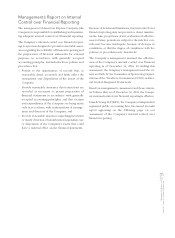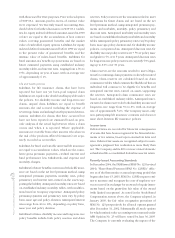American Express 2004 Annual Report Download - page 84
Download and view the complete annual report
Please find page 84 of the 2004 American Express annual report below. You can navigate through the pages in the report by either clicking on the pages listed below, or by using the keyword search tool below to find specific information within the annual report.
Notes to Consolidated
Financial Statements
Note 1 SUMMARY OF SIGNIFICANT
ACCOUNTING POLICIES
The Company
American Express Company (the Company) is prima-
rily engaged in the business of providing travel related
services, financial services and international banking
services throughout the world.
Travel Related Services
The Company’s Travel Related Services operating
segment (TRS), which includes the Company’s card,
travel, merchant and network businesses, provides a
variety of products and services worldwide, including,
among others, global card network, card issuing and
processing services, customized charge card and
credit cards for consumers and businesses worldwide,
other consumer and corporate lending and banking
products, American Express
t
Travelers Cheques and
prepaid card products, business expense management
products and services, corporate travel and travel
management services, consumer travel services, tax,
accounting and business consulting services, magazine
publishing, merchant transaction processing and point-
of-sale and back-office products and services. The TRS
segment operates primarily through the Company’s
wholly-owned subsidiary American Express Travel
Related Services Company, Inc. and its subsidiaries.
American Express Financial Advisors
The Company’s American Express Financial Advisors
operating segment (AEFA) is comprised primarily of
asset management and insurance businesses whose
products are principally offered through its network of
over 12,000 financial advisors. Financial planning and
advice is at the core of AEFA’s business, which helps cli-
ents meet their long-term financial goals. The AEFA
operating segment principally includes American
Express Financial Corporation (AEFC), and its wholly-
owned subsidiaries, the largest of which is IDS Life
Insurance Company.
On February 1, 2005, the Company announced plans to
pursue a tax-free spin-off of the common stock of AEFC
through a special dividend to American Express com-
mon shareholders. See Note 23 for further information
regarding this proposed transaction. The Notes to the
Consolidated Financial Statements include disclosures
that reflect the Company’s business and organization as
currently structured, unless otherwise specified.
American Express Bank
The Company’s American Express Bank operating
segment (AEB) offers products that meet the financial
service needs of three primary client groups: retail cus-
tomers, wealthy individuals and financial institutions.
AEB’s operations are conducted principally through
American Express Bank Ltd., a wholly-owned indirect
subsidiary of the Company, and its subsidiaries. AEB
does not do business in the United States except as an
incident to its activities outside the United States.
Principles of Consolidation
The Company consolidates all non-variable interest
entities in which it holds a greater than 50 percent voting
interest, except for immaterial seed money investments
in mutual and hedge funds, which are accounted for as
trading securities. Entities in which the Company holds
a greater than 20 percent but less than 50 percent voting
interest are accounted for under the equity method. All
other investments are accounted for under the cost
method unless the Company determines that it exercises
significant influence over the entity by means other than
voting rights, in which case these entities are either
accounted for under the equity method or are consoli-
dated, as appropriate.
The Company also consolidates all Variable Interest
Entities (VIEs) for which it is considered to be the pri-
mary beneficiary pursuant to Financial Accounting
Standards Board (FASB) Interpretation No. 46, “Con-
solidation of Variable Interest Entities,” as revised
(FIN 46). The determination as to whether an entity is
a VIE is based on the amount and characteristics of the
entity’s equity. In general, FIN 46 requires a VIE to be
consolidated when an enterprise has a variable interest
for which it is deemed to be the primary beneficiary,
which means that it will absorb a majority of the VIE’s
expected losses or receive a majority of the VIE’s
expected residual return.
Qualifying Special Purpose Entities (QSPEs) under
Statement of Financial Accounting Standards (SFAS)
No. 140, “Accounting for Transfers and Servicing of
Financial Assets and Extinguishments of Liabilities,” are
not consolidated. Such QSPEs include those that the
Company utilizes in connection with cardmember
lending securitizations at the TRS segment, as well
as a securitization trust containing a majority of the
Company’s rated collateralized debt obligations
(CDOs) described in Note 2. Other entities where the
Company has an interest or is the sponsor or transferor
are evaluated using the control, risk and reward criteria
AXP
AR.04
82
Notes to Consolidated Financial Statements
























